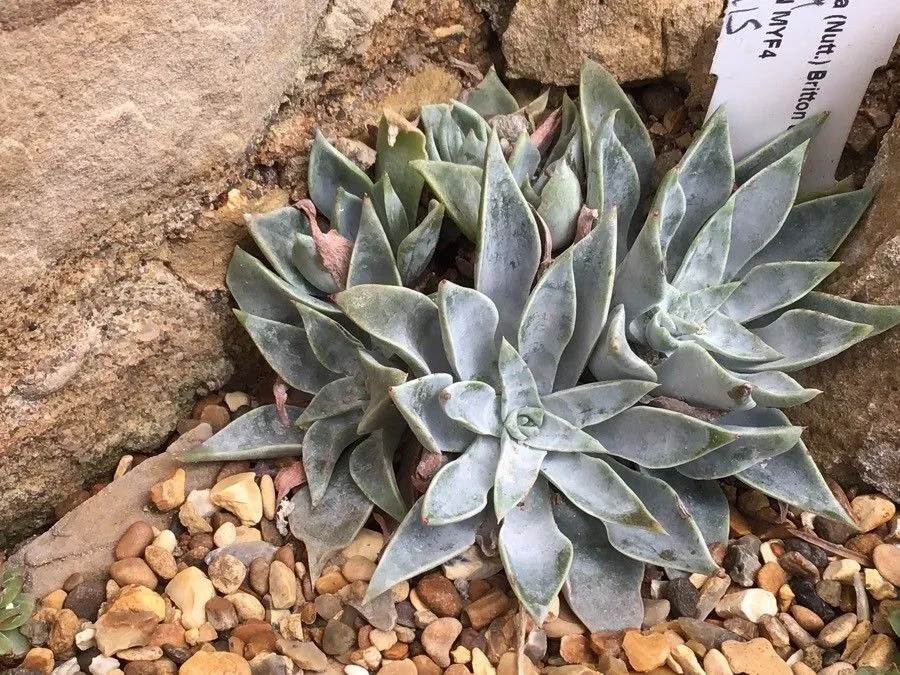
Author: (Nutt.) Britton & Rose
Bibliography: Bull. New York Bot. Gard. 3: 23 (1903)
Year: 1903
Status: accepted
Rank: species
Genus: Dudleya
Vegetable: False
Observations: SW. California to Mexico (N. Baja California)
The Lanceleaf liveforever, scientifically known as Dudleya lanceolata, is a fascinating perennial succulent belonging to the Crassulaceae family. This resilient plant thrives in the arid regions of southwestern California, extending its reach down to northern Baja California in Mexico. Described in 1903 by Nuttall and later classified by Britton & Rose, the Lanceleaf liveforever has garnered attention for its remarkable adaptability and distinctive features.
Characterized by its lance-shaped leaves, this species stands out not just for its drought tolerance but also for its unique aesthetic appeal. The silvery-green foliage forms rosettes that are both appealing and functional, conserving water in their thick, fleshy leaves. These leaves can take on a slight reddish hue under the stress of intense sunlight, adding to the plant’s visual interest.
During its flowering season, the Lanceleaf liveforever produces tall, slender stalks adorned with clusters of small, star-shaped flowers ranging in color from pale yellow to bright orange. These blooms are particularly attractive to pollinators, including bees and butterflies, making the plant a valuable addition to xeriscaping and ecological garden designs.
The natural habitat of Dudleya lanceolata is rocky outcrops and coastal scrubland where the soil is well-drained and nutrient-poor. Its ability to anchor itself into crevices and withstand prolonged dry spells makes it an exemplary model of survival in harsh conditions.
In cultivation, the Lanceleaf liveforever is prized by succulent enthusiasts and gardeners who appreciate its low maintenance needs and striking form. When grown in pots or garden beds, well-draining soil and infrequent watering are key to mimicking its native environment and ensuring healthy growth.
In summary, the Lanceleaf liveforever (Dudleya lanceolata) is more than just a plant; it is a testament to nature’s ingenuity in survival, embodying beauty and resilience in every leaf and bloom. Its presence in the native landscapes of southwestern California and northern Baja California stands as a reminder of the diverse and resilient ecosystems that thrive in arid conditions.
Eng: lanceleaf liveforever
En: Lanceleaf liveforever, Lanceleaf Live-forever
Taken Aug 12, 2020 by Diego Alex (cc-by-sa)
Taken Oct 12, 2022 by KP Laer (cc-by-sa)
© copyright of the Board of Trustees of the Royal Botanic Gardens, Kew.
© copyright of the Board of Trustees of the Royal Botanic Gardens, Kew.
© copyright of the Board of Trustees of the Royal Botanic Gardens, Kew.
Growth habit>: Forb/herb
Family: Myrtaceae Author: (F.Muell.) K.D.Hill & L.A.S.Johnson Bibliography: Telopea 6: 402 (1995) Year: 1995 Status:…
Family: Rubiaceae Author: Pierre ex A.Froehner Bibliography: Notizbl. Bot. Gart. Berlin-Dahlem 1: 237 (1897) Year:…
Family: Sapindaceae Author: Koidz. Bibliography: J. Coll. Sci. Imp. Univ. Tokyo 32(1): 38 (1911) Year:…
Family: Asteraceae Author: A.Gray Bibliography: Pacif. Railr. Rep.: 107 (1857) Year: 1857 Status: accepted Rank:…
Family: Fabaceae Author: Medik. Bibliography: Vorles. Churpfälz. Phys.-Ökon. Ges. 2: 398 (1787) Year: 1787 Status:…
Family: Aspleniaceae Author: (Cav.) Alston Bibliography: Bull. Misc. Inform. Kew 1932: 309 (1932) Year: 1932…